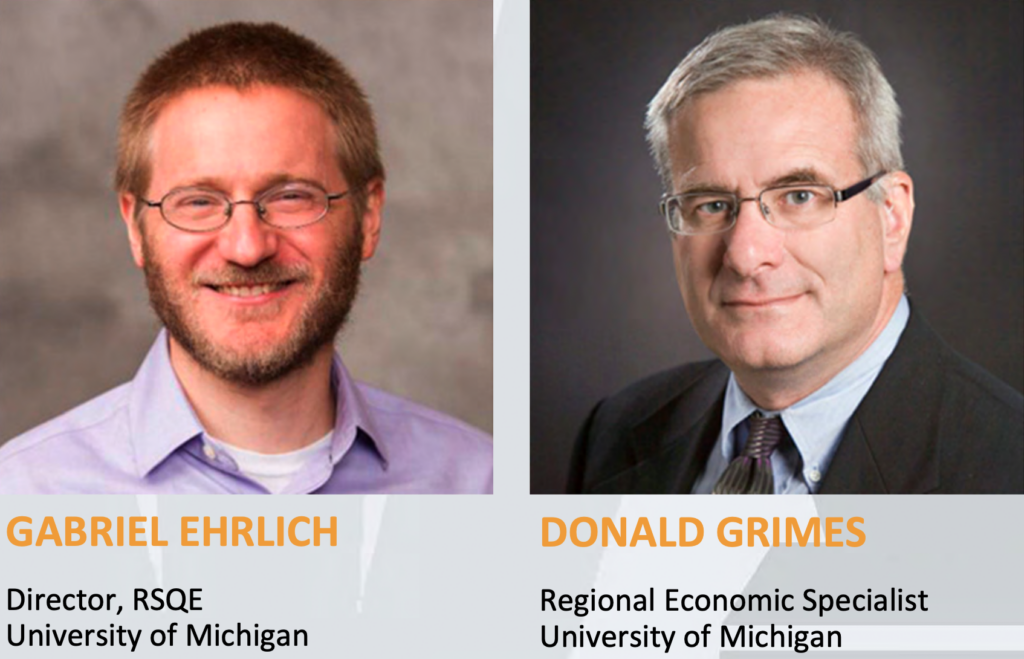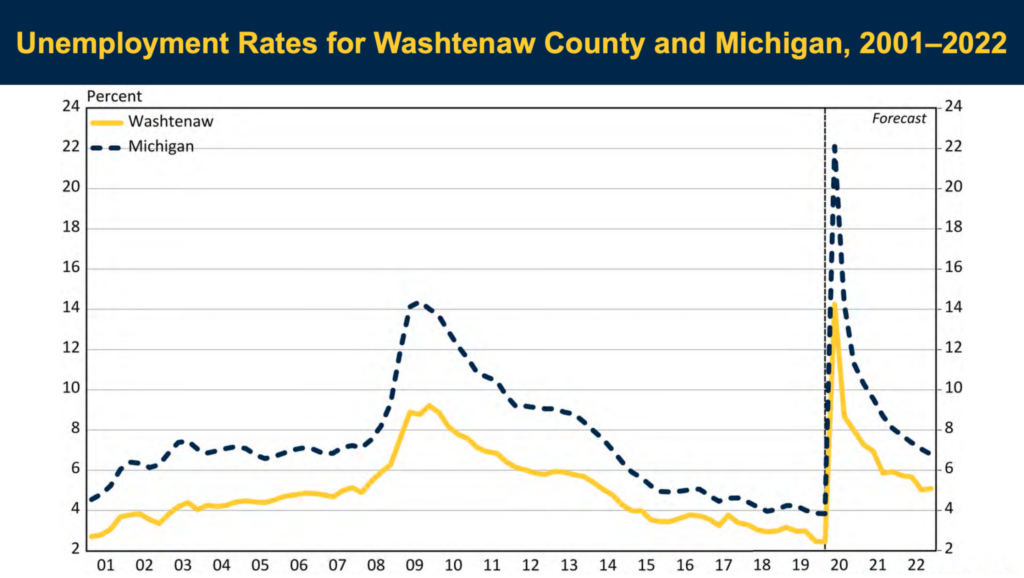

Gabriel M. Ehrlich and Donald R. Grimes from the Research Seminar in Quantitative Economics (RSQE) at the University of Michigan recently presented the Washtenaw County economic forecast during an online webinar organized by the Washtenaw Economic Club — an event that Ann Arbor SPARK is proud to sponsor.
This year’s forecast came in the midst of the COVID-19 global pandemic, one that has significantly impacted Michigan’s residents and will have a far-reaching economic impact. Ann Arbor SPARK’s Director of Research Alex West, who moderated the webinar, provided this high-level summary of the Washtenaw County Forecast.
Read the full report
View the presentation
The path to recovery will be gradual, and conditional.
The forecast was made with a few key assumptions: University of Michigan students returning in the fall, the prevention of a second wave of the outbreak, and federal funding for states and local governments. Even with these conditions, most economic indicators will see a sharp decline this year and a gradual recovery for the next two years, barely reaching 2019 levels by 2022.
- According to Ehrlich and Grimes, even if there is a second wave of infections, it would need to be pretty severe to impact the forecast. This is because healthcare providers and government officials are better prepared now, there is greater testing capacity, and the public is better informed.
- However, federal funding for state and local governments is essential. Due to the severe risk of deeper recession and the fact that it is a national problem, Ehrlich and Grimes think it is very likely that the funding will come through.
- One key differentiator between now and the 2009 recession is that we did not enter this crisis with a fundamental imbalance in the economy. This has subtle but profound implications for housing, financial institutions, and other cornerstones of the U.S. economy. In other words, issues within those industries were not the cause of the crisis, and while they may have slowed down, there isn’t a critical danger of collapse.
The University of Michigan remains a constant source of stability.
Washtenaw County has held up better than other communities throughout Michigan as well as compared to the state as a whole. This is largely due to the University of Michigan acting as a regional stabilizer, even amid wage freezes and layoffs. The institution itself remains, which significantly impacts present and future economic indicators.
- While this outlook relies on averages, it’s important to remember there are segments of the population carrying a more significant burden when it comes to the economic impact of COVID-19. One key takeaway was the continued widening of the gap between low-wage workers and knowledge workers in the county, which is unfortunately also a racial and geographic gap. According to Ehrlich and Grimes, these will continue to widen without significant policy intervention.
Washtenaw County industries will not all fare equally.
Based on a myriad of factors — some existing before the pandemic — certain industries in the county may not recover from this recession. On the other hand, some industries will experience a minimal impact while others may grow. However, the recovery will not keep up with the growth in the labor force. As a result, Ehrlich and Grimes forecast an increase of the unemployment rate from 2.9 percent in 2019 to 5.4 percent in 2022.

- Manufacturing: Washtenaw County has seen a decline in manufacturing jobs for over a decade for other reasons, such as automation. COVID-19 may accelerate this trend and result in permanent job losses, which once again influences the widening gap between low-wage and knowledge workers.
- Retail: The retail sector has been losing jobs since 2001. The COVID recession will accelerate this job loss and it may not recover. However, those job losses will become job gains in wholesale, transportation, and utilities services.
- Leisure and Hospitality: This is the industry hit hardest by the COVID recession. These jobs are forecasted to only make a partial recovery by 2022.
- Wholesale, Transportation, and Utilities Services: This category encompasses everything crucial for supply chain logistics (warehousing, trucking). This sector has been growing considerably and will accelerate its growth as a result of the pandemic.
- Professional Services: Washtenaw County has a more diversified professional services industry than the state as a whole. The region’s tech jobs are spread out across multiple industries and not concentrated in automotive. This sector will continue to grow.
- Private Education and Health Services: This is a continually growing industry (health services more than education) that is not forecasted to lose many jobs at all during this recession.
Caveats remain, the overall outlook is hopeful.
While Washtenaw County has not escaped the impact of the COVID-19 Recession, this region will fare relatively better than the state and nation as a whole. Overall (and given significant assumptions), RSQE forecasts that Washtenaw County will experience a two-year economic setback, with unemployment numbers lagging behind other key indicators. The University of Michigan’s presence anchors the region, providing jobs and an influx of the student population which bolsters the local economy.
Read the full report
View the presentation